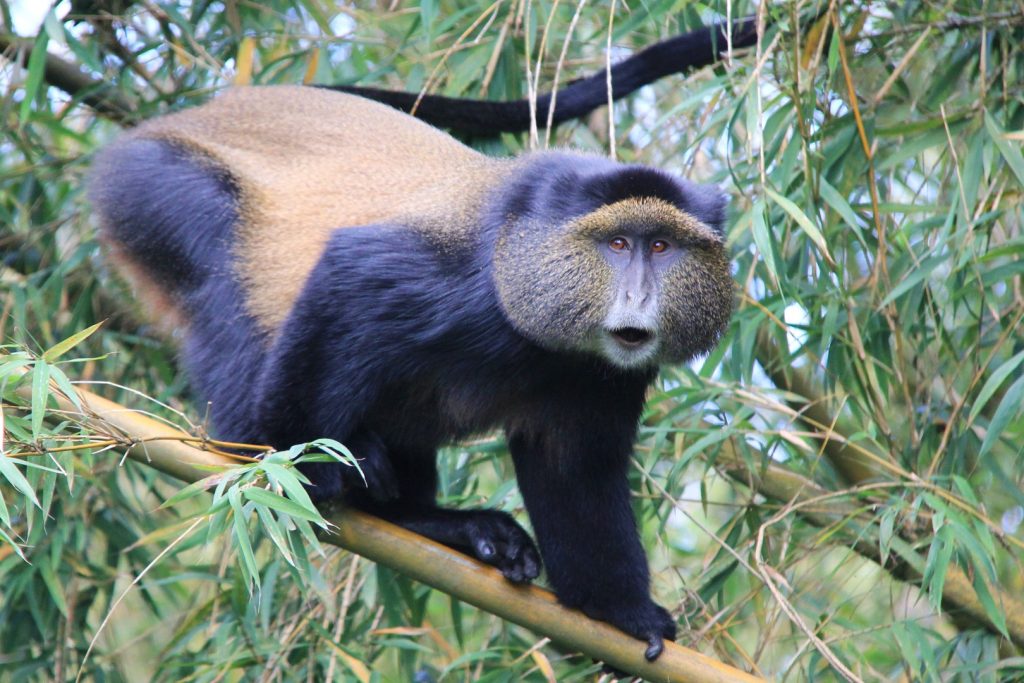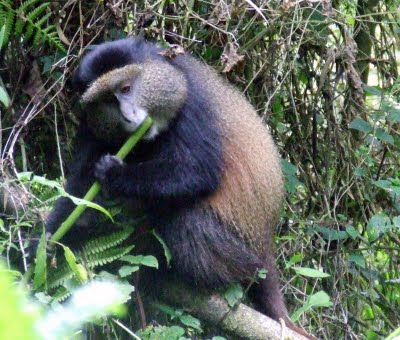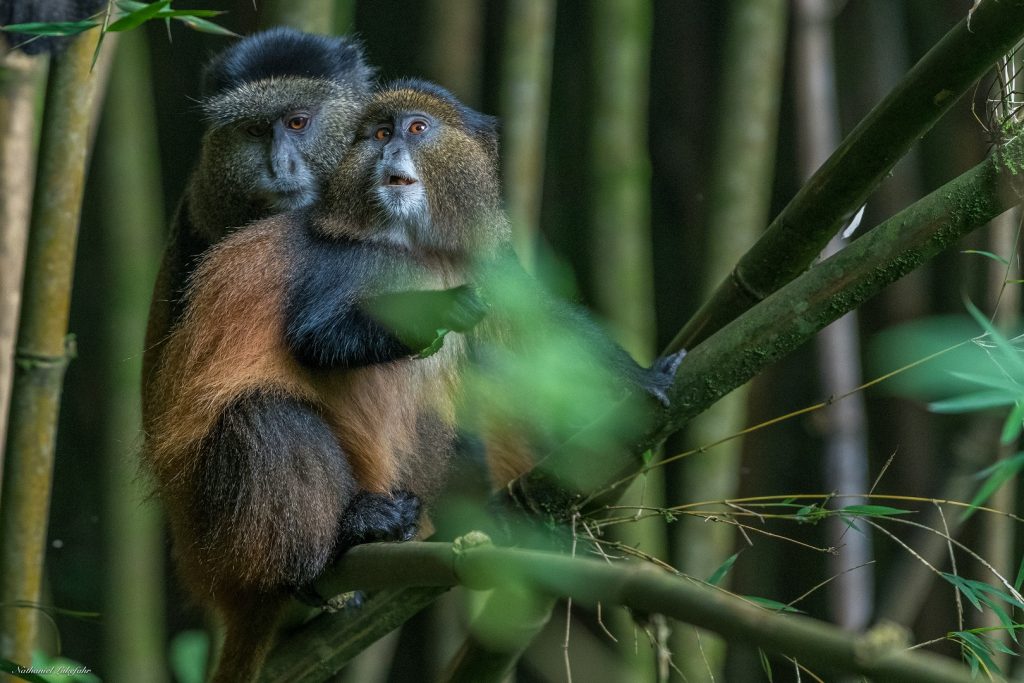
Golden Monkey Trekking in Mgahinga Gorilla National Park is the second most exciting activity for visitors in the park . Mgahinga National Park for many years is well know for Mountain Gorilla trekking and this is a second home of these special gorillas in Uganda. Bwindi Forest National Park in Uganda holds the largest population of the Mountain Gorillas world over. Book Now
Golden Monkey Trekking Mgahinga, you can try your hand at tracking the fascinating species, where you can join a tracking excursion at the park and explore the Virunga mountains where the last breeding populations of Golden monkeys live. The chance to observe these monkeys in the wild is a once-in-a-lifetime opportunity that is sure to become one of the highlights of your Uganda vacation. This will also be a memory to cherish for years to come as hopefully, you have been intrigue by its assortment.
Mgahinga National Park borders Volcanoes National Park of Rwanda, this is also a home to a large population of Golden Monkeys and Golden Monkey trekking is very popular in Rwanda. You need to obtain a golden monkey trekking permit before going for this activity.

What are Golden Monkeys?
The Golden Monkey Trekking Mgahinga is what is known as an “Old World Monkey“. Old World Monkeys are a family of monkeys known as Cercopithecidae, which includes two subfamilies, Cercopithecenae and Colobinae. The golden monkey belongs to Cercopithecenae. Between these two subfamilies, there are over 132 species of Old World monkeys.
The Old World monkeys can be found in Uganda and other parts of Africa and New World monkeys, on the other hand, live in Central and South America, as well as Mexico. Old and New World monkeys are also separated by a surprising anatomical feature: their noses! Old World monkeys, including the Golden, have nostrils that point downwards, whereas New World monkeys have nostril that point to the sides.
The golden monkey driven their name from as you may have a thought of, the Golden monkey gets its name for its striking coloring. The tails of the Golden monkey are bright, vibrant, golden orange, as are its cheeks, and patches of its back and torso. This poses a sharp contrast to its jet-black legs and head for a visually stunning effect. The Golden monkey a distinct species as they is currently recognized as its own genetically unique species, you may be surprised to find out that it is only relatively recently that the Golden monkey has been recognized as such. It used to be considered a subspecies of the closely related, but distinct, blue monkey (Cercopithecus mitis).
It’s a stimulating rhapsodic experience in an Albertine Rift Endemic where Golden monkey they live in Albertine Rift is a geographic area of mountains and valley that is confined between the northern side of Lake Albert and the southern tip of Lake Tanganyika. It includes a part of Uganda, but also portions of the Democratic Republic of the Congo, Burundi, Rwanda, and Tanzania.
“Endemic” is a term that refers to the population of a species that is confined to a certain area. They used to live in broader areas of Uganda and other African nations, but can now only be found in the Albertine Rift. The Albertine Rift is a place of magnificent beauty and unsurpassed biodiversity. Over half of all of Africa’s bird species call it home, along with just under half of its mammals and nearly a quarter of its plants and amphibians (along with quite a few humans). The Golden monkey is certainly in good company in this protected area.
The Golden monkey belongs to the International Union for Conservation of Nature (IUCN). According to the IUCN, the Golden monkey has been an endangered species since 1996. The IUCN includes the Golden monkey on this list for a few reasons. The Golden monkey is estimated to have a population of only 2,500-3,500, and this population is dwindling. The Golden monkey’s habitat is now confined to an area about 5,000 square kilometers in the Albertine Rift.
Golden monkey behaviours to know before trekking
The golden monkey lives mostly in bamboo forests, and are subject to the constant threat of habitat loss and deforestation. The Golden monkey’s have few animal predators (with certain bird species being an occasional, but relatively inconsequential, exception) so the main threats to its life are humans who may set illegal traps and snares, or cut down the bamboo that Golden monkey’s lives depend on.

While it is mostly herbivorous, Being living in bamboo forest, this has enabled them to feed on bamboo leaves and shoots, as well as other types of fruits, flowers, and leaves, it can also be guilty of enjoying the occasional insect and invertebrates. Due to its diet the golden monkey prefers a habitat with abundant fruit and bamboo. The golden monkey will move in between areas depending on the season where ripe fruit is available they will remain in those areas and when the rainy season begins this causes bamboo shooting to occur and the thus why are found more in Mgahina.
Studies have found that if there is an area consisting of mixed fruit and bamboo, the monkeys will tend to frequent that area more than an area of just bamboo this evidence in Mgahinga where most frequently seen in forests with bamboo, and this may suggest that this is one of the major preferences of the species. It has also known to snack on up to 30 species of plants, its favorite food is bamboo. This is one of the Golden monkey adaptations that helps it survive in a climate with a great variance of natural conditions.
What to watch out for during golden monkey trekking in Mgahinga?
One of the qualities that make monkeys and other primates so fascinating is that they often live in complex social webs with relationships and bonds that can be reminiscent of those of humans. The golden monkey can travel in various group sizes, and have been seen in small groups of three up to large groups of 62 monkeys where they are too friendly to people, this brings out the true picturesque of Mgahinga. The groups that are found at higher elevations tend to be smaller. The golden monkey will often return to one of several different sleeping areas after a day of feeding.
The monkeys often sleep in small subgroups of four, at the top of bamboo plants. They will often use a dense bamboo plant, or a combination of several bamboo plants that weave together to make a sufficient foundation for sleep. The golden monkey will often feed near the sleeping area and return to this same sleeping location day after day. They have been known to live in smaller groups of only a few individuals. Out of this group, there is usually only one male! The females tend to guard one territorial region while the males may mate and then travel pack-to-pack. Given the opportunity to live out it’s natural life span, the Golden monkey will live for up to 20 years.
However the baby Golden monkeys their mating habits of this species are largely under researched, we do know that the species mating rituals are what is known as “polygynous” meaning the one male in the pack will mate with nearly all of the females. However, it is actually the female that must initiate the mating process. It continues to take five months of gestation for a baby golden monkey to be born. Interestingly, the baby Golden is born with all of its fur and wide-open eyes, during the birth time, the mother will care for her infant for two years until it reaches the age and after the male Golden will leave their pack, while the females will typically live out the duration of its life in the group it was born in.
While here, where the Golden monkeys nest in relying on bamboo for nutrition, the Golden monkey also uses bamboo to craft little homes. In an astounding feat of intelligence, Goldens actually weave multiple bamboo plants together to make beds. The golden monkey will travel a bit during the day to feed, but return to these beds for rest night after night for a period of time.
They normally communicate as Males primarily use their calls as signs of aggression and territorial defensiveness, while female calls have more social functions, such as identifying themselves as part of a group as well the young group will use calls to demonstrate their submissiveness. In addition to vocalizations, Golden monkeys have highly emotive features and are known to communicate with each other through these facial expressions.
Within the Golden monkey family they are also anther species which are native in Mgahinga park also In Cercopithecus family are Blue monkey, Silver monkey, Red-tailed monkey, De Brazza’s mokey, L’Hoest’s monkey. Of these, the Blue monkey is the most common and L’Hoest’s monkey is the most elusive. While these species all belong to the same genus, their habitats, appearances, and social lives vary greatly.
Most visitors that participate in the trekking of the Golden Monkey trekking in Mgahinga, spares time to hike the one of the 2 Volcanoes including, hiking Mount Sabinyo, hiking Mount Muhabura or hiking Mount Gahinga.
Book Now